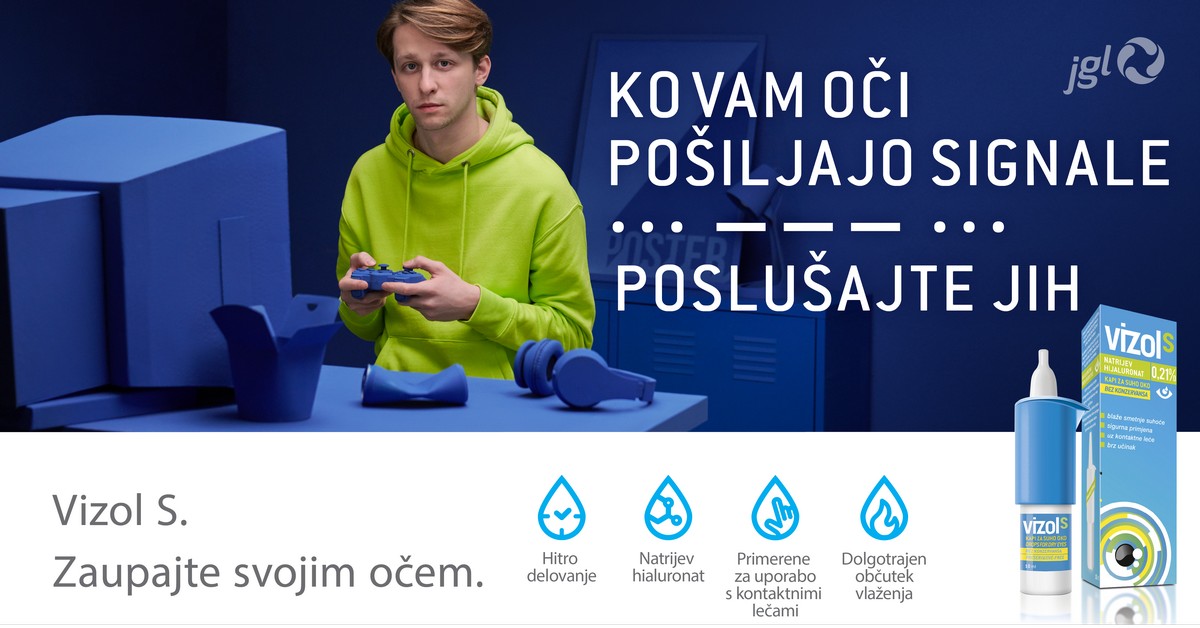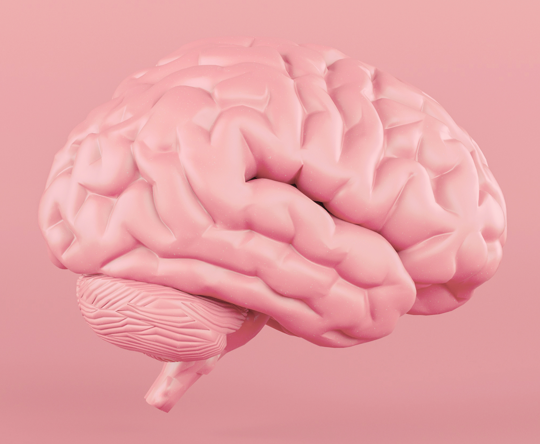At the pharmacy, when it comes to mild discomforts in patients who are already familiar with the problem of dry eye and when we have excluded the possibility of injury to the eye, we recommend self-medication.
In addition to the recommendation to use artificial tears, people with mild to moderate dry eye disorders can also benefit from advice on proper lifestyle and hygiene. More on this topic from Bojan Madjar, mag. pharm.
According to the estimates by the World Health Organization, there are a total of 2.2 billion people in the world who have an eye disease, and for at least a billion of them the disease could have been prevented. Apart from aging and genetic predispositions, eye health is influenced by many other factors we have control over ourselves, which enables us to prevent disease and improve our health. This is why leading ophthalmologists, neurologists, endocrinologists, psychiatrists, rheumatologists, otorhinolaryngologists, plastic surgeons, general practitioners, pharmacists and engineers are brought together at X-Lab — the expert research hub by JGL — to analyse the latest research and, by applying a holistic approach, to share with us how to take care of our eye health and why that is important for our whole bodies.
1 For which disorders do you recommend using products for dry eye?
People with mild dry eye disorders usually report one or more discomforts: dryness, irritation, eye fatigue, burning, foreign body sensation or a sensation of sand in the eyes, stinging, mild itching, pain, blurred vision that worsens during the day, tearing (epiphora), sensitivity to light and wind, poor tolerance of contact lenses, mucous discharge. At the pharmacy, we recommend self-medication for mild disorders, when the possibility of mechanical or thermal damage to the eye is excluded, and when the patient is already familiar with the problem of dry eye and has experience with using over-the-counter drugs or medical products for adolescents or adults from previous treatments of eye disorders.
We don’t recommend self-medication to children (especially children still in preschool) and to people with more severe disorders (pain, redness from irritation, strong purulent discharge, closed eyelids, very blurred vision, rapid worsening of symptoms), eye damage due to a foreign body in the eye or chemical or thermal exposure of the eye, or allergies (seasonal problems), if their condition doesn’t change for the better or for the worse within three days of starting self-medication. However, it is always best to have an ophthalmologist make the diagnosis before treatment. Symptoms that look like dry eye disorders can also be an indicator of other diseases.
2 What should everybody who uses dry eye relief products pay attention to?
Dry eye products, also called artificial tears, can contain a variety of ingredients. The compounds in the ingredients that increase viscosity and prolong the lubrication of the surface of the eye are essential. Products with these properties are particularly suitable for the hyposecretory dry eye where there is an aqueous tear layer deficiency. Discomforts such as dryness, the sensation of sand in the eyes, and redness are more pronounced in the evening. More viscous preparations are especially suitable for people with severe dry eye disorders or for people who, for various reasons, can’t use the product more often.
In case of excessive tear evaporation, we recommend using products rich in lipid components because they reduce tear evaporation by restoring the lipid layer of the tear film. With the evaporative form of dry eye, you may notice that problems such as eye irritation and redness are more pronounced in the morning. Then, after several hours of working at the computer, increased tearing (epiphora) occurs, which may also be present when the eyes are exposed to wind and cold air. In the pharmacy, it is difficult to identify the form of dry eye based on the description from the patient, especially because the symptoms appear in different proportions in different people. Products in the form of drops dominate the market, there are fewer gels and sprays. Eye gels allow longer eye lubrication, so they are more suitable for the night. However, it’s important to keep in mind that gels can cause blurred vision, especially after prolonged use. Dry eye preparations can be single- dose or multi-dose. Usually, single-dose preparations are the ones that are preservative- free. They are suitable for frequent and long-term use, for contact lens wearers and, of course, for people with hypersensitivity to preservatives. Multi-dose preparations with preservatives are more durable, but have some limitations due to the added preservative. There are many different preservatives, but they are still commonly not recommended for contact lens wearers because they can cause irritation and blurring when they accumulate on the contact lenses. As a rule, they are recommended for short-term use — preservatives, especially after long-term use, can worsen the symptoms of dry eyes further and cause irritation and damage the cells of the eye surface. Because of this, they are not the most suitable for people with moderate to severe dry eye disorder who need to use the product frequently.
Preservative multi-dose preparations have similar properties, but must be handled with care to avoid contaminating the container. Some users prefer softer plastic containers, while others prefer those that have dosing caps. The decision between the two kinds of preparations may be influenced by the expiry date after first opening, and the price can also not be ignored.
3 How should we use dry eye products properly?
Wash your hands thoroughly before using eye drops. In all circumstances, pull the lower eyelid down with the fingers of one hand, look up and let out one drop into the inner corner of the eye. Blink a few times with your head tilted back. If you are experiencing issues with balance, you can also lie down. Blink several times after application. Your vision will be blurred for a while after application, especially when you’re using more viscous preparations (e.g., gels), so do not do anything straining for the eyes immediately after application.
Regardless of the pharmaceutical form (drops, gel, ointment), when applying a medical product to the surface of the eye, be careful not to touch the eye, the eyelid or lashes with the tip of the container or tube. This poses a risk of infection (especially with multi-dose and preservative-free preparations) and / or corneal damage.
The dosing and application frequency depends on the severity of the disorder. With milder disorders the medical product is applied less often (at least once to twice a day), and with more severe disorders more often (three to four times a day or even more). In general, we recommend using the product regularly, not just as needed. If we’re using different medical products for the eye, we should wait at least five minutes between the application of each. The usual rule is: the more viscous the product, the later should it be applied, meaning for example that drops should be used first, then gel or ointment.
4 How can we store dry eye products properly?
Close containers tightly immediately after use. Drops and other products used to alleviate dry eye symptoms are usually stored at room temperature. Do not expose them to heat sources. Each container or outer packaging (box) has an expiration date. The preparation must not be used after the expiration date. At the same time, keep in mind that usability is limited as soon as you open the container for the first time. In principle, these kinds of medical products should be used for a few weeks to a few months after first opening. Single-dose preparations that are discarded after use are an exception. Even if the expiration date has not passed, the product should not be used if too much time has passed after first opening.
5 At your pharmacy, what other measures do you recommend for dry eye besides preparations?
In addition to recommending artificial tears, people with mild or moderate dry eye disorders can also benefit from advice on proper lifestyle, which includes the use of humidifiers, quitting smoking, and taking regular breaks from working at the computer. People who spend a lot of time at the computer should position the upper edge of the screen at eye level to decrease eyelid cleft and to reduce tear evaporation. When you’re looking at a screen for a long time, whether you’re watching TV, working on a computer, or looking at a smartphone, try and blink consciously and often. We tend to blink less often when we’re looking at a screen, and this reduces the lubrication of the surface of the eye. Appropriate hygiene and warm compresses are recommended for people with eyelid inflammation (blepharitis) or Meibomian gland dysfunction (MGD).
(This content is the result of independent clinical experience and the professional work of the author and does not necessarily reflect the opinion and attitude of the client.)
QUIZ
SUFFERING FROM DRY EYE SYNDROME? ANSWER THESE QUESTIONS AND FIND OUT HOW TO PREVENT IT AND WHAT TO DO WHEN YOU ARE ALREADY FEELING THE SYMPTOMS
QUIZ





